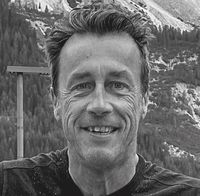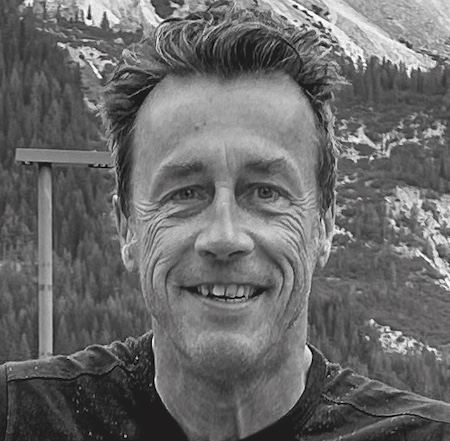'Cycling is my medicine': Pioneer of Operation Close Pass on refusing to let chronic pain curtail his riding
Cycling policeman Mark Hodson tells us about being diagnosed with axial spondyloarthritis and how it's broadened his appreciation for bikes


This article was originally published in Cycling Weekly's print edition as part of the long-running MY FITNESS CHALLENGE series.
When he wasn’t riding “undercover” to catch out cyclist-endangering motorists, ‘Operation Close Pass’ founder PC Mark Hodson was training with his local club Tamworth RMCC. But last autumn he was diagnosed with an inflammatory arthritic condition and suddenly his attitude towards cycling had to change.
“Riding for me used to be all about the suffering and beating my average speed,” he says. “I was very competitive and I’d even try to PB the commute to work. These days I ride to lessen the suffering – it reduces the inflammation so it’s effectively a medicine for me.”
Hodson explains how he first realised he had a problem: “I literally had to pull myself out of the car after a shift patrolling the motorway. I’d had pain in my back and joints for years, which I put down to bad running posture, wearing a stab vest and sitting in patrol cars all day.” His GP referred him to a rheumatology consultant who diagnosed his condition as axial spondyloarthritis. He was prescribed anti-inflammatory drugs and painkillers and told to avoid “triggering” activities.
“I thought I’d be in there for 10 minutes,” he recalls of the appointment last September. “Instead, I came out three hours later feeling as if I’d been hit by a freight train. I was told this could mean the end of my career – I had to face the fact I’d probably locked up my last prisoner and driven a police car in anger for the final time.”
So Hodson jumped on his bike. Though running and gym work were now prohibited, cycling and swimming were recommended for reducing inflammation. And Hodson had years of experience as a cyclist, both as a member of his local club and as co-founder (with colleague Steve Hudson) of Operation Close Pass. The initiative saw undercover cops on bikes identify and apprehend motorists driving without due care and attention. What started as a local operation in the West Midlands in 2016 is now practised by police throughout the UK and Europe.
“I’m lucky that my lifestyle as a cyclist has helped me,” says Hodson. “The reason I’d managed the pain for so long [before being diagnosed] was because I used to commute to work by bike. Cycling has also been good for my mental health, as being told my career could be over at just 48 was a big psychological blow.”
The latest race content, interviews, features, reviews and expert buying guides, direct to your inbox!
Hodson now works from home, as the painkillers he has to take forbid him from driving. His morning routine is all about reducing the discomfort in his joints, culminating in a pain-relieving bike ride. “Each morning when I get up, it feels like I’ve been in a car crash,” he says. “The first hour is about getting some flexibility back: I empty the dishwasher, bending down to stretch the muscles. Then I’m ready to either take the dogs for a walk or ride the bike. Only after I’ve done that do I feel like a normal person again.”

How does riding ease his symptoms? “Not only is cycling good for stretching the back and legs, it builds up the muscles around the joints. Cycling used to be all about training for me, but now I’ll jump on the bike in what I’m wearing to go to the shops.” So potent is the effect that sometimes cycling replaces his medication. “If I can’t take my painkillers because I need to drive, I’ll jump on the bike or turbo for 15 minutes to ride out the inflammation. I can feel the pain leaving and afterwards I’ll only need half my regular dose.”
Hodson has had to make compromises with other aspects of his cycling, though. “Now when I ride it’s at a leisurely pace rather than trying to break any records,” he says. “Club rides are also out because I can’t risk being too far from home in case I need my pain relief.”
This change in his cycling has extended his empathy to a broader spectrum of riders. “Whereas I used to ride to get fitter and faster, now it’s primarily about making my condition bearable. I ride in normal clothes down to shops on my hybrid with a rucksack on my back and associate myself more with people who ride [out of necessity],” he reflects. “Close Pass was about enabling people to cycle in a safe environment – people I now identify with more than I did before.”
Hodson’s condition means he’s no longer spending hours on the beat. Instead, he’s working from home to standardise “third-party reporting” – the uploading of video evidence to police force websites.
As for his own riding, Hodson’s condition hasn’t prevented him from making some big goals. “The more cycling I do, the better I will be day to day, so I’m going to be setting yearly mileage targets: 6,000 for this year, then increasing by 2,000 miles a year until I get to 12,000 – I’d be happy with that.” The goals of his riding may have changed but the enjoyment remains. “I love fishing, so I’m going to start going fishing by bike,” he adds with a smile, “that should be fun!”
Doctor's orders: 'Exercise reduces pain'
Consultant rheumatologist Dr Raj Sengupta tells us more about the condition axial spondyloarthritis
“It is not a rare condition, nor is it confined to the elderly. Axial spondyloarthritis affects about one in 200 people. Typically, symptoms first appear in late teens to early 20s but with diagnosis years later.
“The mainstay of treatment currently is exercise and anti-inflammatories. Exercise such as cycling has been shown in a number of different studies to be beneficial for patients. Those who exercise regularly have less pain, better posture, better mobility, better sleep and less fatigue. It is also important to recognise that one size does not fit all – a physiotherapy defined strengthening and stretching programme is the ideal way for patients to benefit.”
For more info visit: nass.co.uk
This article was originally published in the 1 September 2022 print edition of Cycling Weekly magazine. Subscribe online and get the magazine delivered to your door every week.

Trevor Ward is a veteran journalist who has experienced writing from war zones, rubbed shoulders with music royalty in various green rooms, but now specialises in writing about cycling. He is a training Bikeability instructor and can often be seen riding along the east coast of Scotland